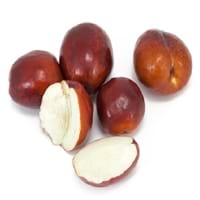Health Benefits
Boosts immune system, Boosts respiratory health, Cancer prevention, Digestive aid, Piles treatment
Cancer prevention, Diarrhea treatment, Improves muscular strength, Liver health, Maintains hormonal balance, Reduces nervous tension, Reduces blood circulation problems, Reduces stress, Regulation of heart rate, Treatment of hysteria
General Benefits
Beneficial in improving nerve function, Protects against parasites and worms, Relieves pain
Anti oxidant properties, Digestive aid, Flu treatment, Helps in weight loss, Strengthens bones, Treatment of common cold
Skin Benefits
Anti-aging benefits, Brightens and lightens complexion, Exfoliates skin, Hydrates skin, Treatment of dark spots
Heals sunburn, Hydrates skin, Reduces wrinkles, Skin rejuvenation, Skin revitalization
Hair Benefits
Prevents hair loss
Promotes longer and healthier hair, Protects hair
Allergy Symptoms
Abdominal pains, Breathing difficulty, Dizziness, Eczema, Fainting, Hives, Itching, Nasal congestion, Swelling of face, Tingling sensation in mouth, Vomiting
Abdominal pains, Breathing difficulty, Diarrhea, Hives, Itching in eyes, Itching of nose, Nasal congestion, Redness of eyes, Runny nose, Sneezing, Wheezing
Side Effects
Decrease in blood sugar levels, Induces acid reflux, Allergic reaction, Tooth decay, May form gallstones
Decrease in blood sugar levels, Intense headache
Lactating Women
No
Not Available
Best Time to Eat
Along with meal, As a snack in the late afternoon, Don't consume at night and before bed, Strictly avoid empty stomach
As a snack in the late afternoon, Don't consume at night and before bed, Morning time (before lunch), Strictly avoid empty stomach
Vitamin B5 (Pantothenic Acid)
Not Available
Vitamin B9 (Folic acid)
Not Available
Vitamin C (Ascorbic Acid)
Vitamin E (Tocopherole)
Not Available
Vitamin K (Phyllochinone)
Not Available
Lutein+Zeaxanthin
Not Available
Phytosterol
Not Available
Calories in Fresh Fruit with Peel
Not Available
Calories in Fresh Fruit without Peel
Not Available
Calories in Frozen Form
Not Available
Calories in Canned Form
Not Available
Not Available
Calories in Juice
Not Available
Calories in Jam
Not Available
Calories in Pie
Not Available
Season
Spring, Summer
Autumn, Summer
Varieties
PKM 1, Urigam, Hasanur, Tumkur prathisthan, DTS 1 and Yogeshwari
Honey Jar, Sugar Cane, Li, Shanxi Li, Sherwood, Chico, Silverhill, Tigertooth, Winter Delight and Lang
Color
Brown, Reddish-brown
Green, Red, Yellow
Shape
Curving Cylinder
Round
Soil Type
Loam, Sandy, Sandy loam, Well-drained
Sandy, Well-drained
Climatic Conditions
Humid to dry, Rainfall, Warm to hot climate
Warm to hot climate
Facts about
- Tamarind is used to prevent body odor.
- African children use the tamarind seeds in games.
- No cases of tamarind toxicity or allergy reported till date.
- Pigment extracted from Indian jujube is used for silk dyeing in Burma.
- In Korea, jujube wood is used to make wind instrument taepyeongso.
- Fresh jujube is known as Chinese apple & dried form is called as Chinese date.
Other Countries
Africa, Australia, Brazil, China, Mexico, Nigeria, Sudan, Taiwan
Bangladesh, India, Iran, Korea, Lebanon, Pakistan
Top Importer
United States of America
United States of America
Top Exporter
Thailand
China
Botanical Name
Tamarindus indica
Ziziphus zizyphus
Synonym
Tamarindo, tamarindus
Ziziphus jujuba or Ziziphus mauritania or Zizyphus jujuba
Subkingdom
Tracheobionta
Tracheobionta
Division
Magnoliophyta
Magnoliophyta
Class
Liliopsida
Magnoliopsida
Family
Fabaceae
Rhamnaceae
Genus
Tamarindus
Ziziphus
Species
Tamarindus indica
Z. zizyphus
Generic Group
Tamarind Sub
Not Available
Difference Between Tamarind and Jujube
We might think that Tamarind and Jujube are similar with respect to nutritional value and health benefits. But the nutrient content of both fruits is different. Tamarind and Jujube Facts such as their taste, shape, color, and size are also distinct. The difference between Tamarind and Jujube is explained here.
The amount of calories in 100 gm of fresh Tamarind and Jujube with peel is Not Available and 79.00 kcal and the amount of calories without peel is 239.00 kcal and Not Available respectively. Thus, Tamarind and Jujube belong to High Calorie Fruits and High Calorie Fruits category.These fruits might or might not differ with respect to their scientific classification. The order of Tamarind and Jujube is Fabales and Rosales respectively. Tamarind belongs to Fabaceae family and Jujube belongs to Rhamnaceae family. Tamarind belongs to Tamarindus genus of Tamarindus indica species and Jujube belongs to Ziziphus genus of Z. zizyphus species. Beings plants, both fruits belong to Plantae Kingdom.









